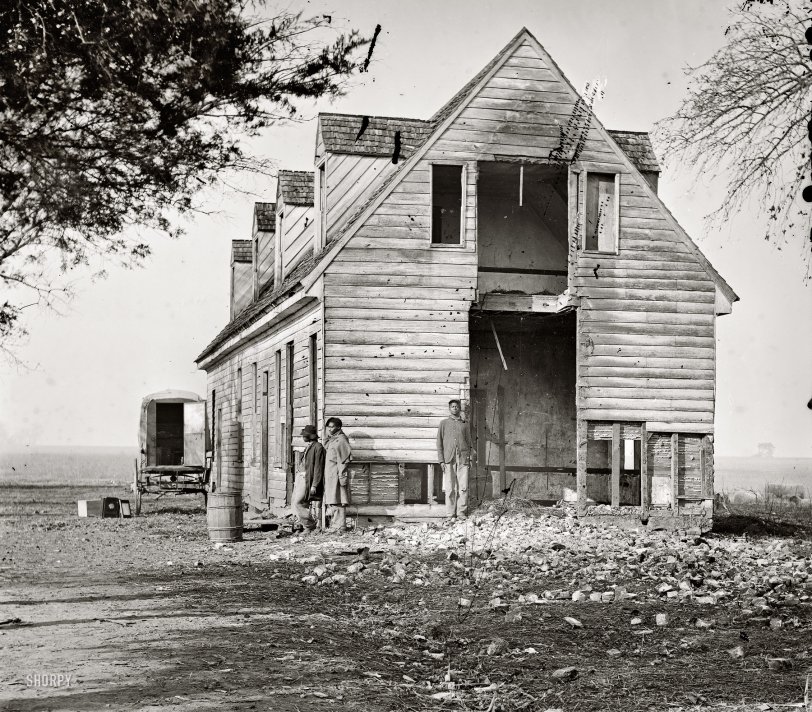


Framed or unframed, desk size to sofa size, printed by us in Arizona and Alabama since 2007. Explore now.
Shorpy is funded by you. Patreon contributors get an ad-free experience.
Learn more.

- Lofty addition
- In 1912
- Keenan Building
- Six years old
- Taken from the P.J. McArdle Roadway?
- It stood only 47 years
- Three track mind
- Incline to the right
- Reach for the sky, 1912 style
- No clean sweep
- Same Job Title, Same Face
- Sadly Lost
- Beautiful ...
- Where you get your kicks
- Aim High
- Pueblo Revival sisters
- Pueblo Neoclassicism
- Milk Man
- Regional dialect.
- Spielberg's inspiration
- Great Photo
- Loaf Story
- Do you still have the Rakes category?
- Could almost be a scene from the 1957 movie 'Hell Drivers'
- The Wages of Fear.
- Conspicuous by their absence
- Got Milk?
- All that aluminum
- No lefties
- Smoke 'em if you've got 'em
Print Emporium
Dutch Gap: 1864

November 1864. "Dutch Gap, Virginia. Picket station of Colored troops, deserted farmhouse near Dutch Gap canal." Wet plate glass negative. View full size.
Horsehair Plaster
Each time we're involved in remodeling or demolishing a very old house (40 years now), we encounter horsehair plaster over wood lath strips; the hand-removal of which may be the dirtiest job in the construction industry.
Pasty substance
What would that gluey pasty looking substance be between the boards? Just boards on both sides of the 2x4's?
[The "boards" (thin strips of wood) are lath. The "pasty substance" is plaster. - Dave]
Newish Construction
This looks like it's built with balloon frame stud walls, not post-and-beam. That's definitely latter-half 19th-century building technology. My house was built in 1874 and it looks just like this one.
Colonial chimneys
In Virginia in the 1700s, chimney fires were fairly common. If you could throw some ropes around the chimney, and pull it down, you'd save the rest of the house from burning. For this reason, chimneys of the period were typically not flush with the wall of the house..at least not above the second story fireplace. This made is easier to pull them down in case of fire. There's examples of this type of construction throughout the Virginia Tidewater, from wealthy homes to small log cabins.
The chimney
That must have been a most unique chimney. Don't believe I've ever seen one with such an extremely pitched roof topping it, at least as evidenced by the unfaded area on the attic gable. And typically, one would see a chimney rising above a roofline, not stopping below the fascia. I will look for an example of these unique chimneys in future Shorpy photos of this era.
[I'm sure the chimney did go above the roof. That little peak would be the top of the bricks between the flue and the house. - Dave]
This photo is proof positive
This photo is proof positive that digital will never, ever live up to film. The clarity is stunning.
- Suzanne
[True. Although I might note that "film" did not exist when this photo was made, on glass. It was the transition from glass to film that started photography down that slippery slope to grain and fuzziness. And even pictures made on glass using the wet-plate process weren't as sharp as a good daguerreotype. Which you'd need to see in person to fully appreciate. Printed reproductions cannot do them justice! - Dave]
Missing Chimney
I wonder if the chimney got pulled down because scavengers wanted the bricks.
Brick thieves?
This house was old even in 1864. My guess is that it dated back into the 1700s. It's a dead ringer for many of the houses still to be seen in Colonial Williamsburg. Someone has totally removed the massive brick chimney and fireplaces.
























On Shorpy:
Today’s Top 5